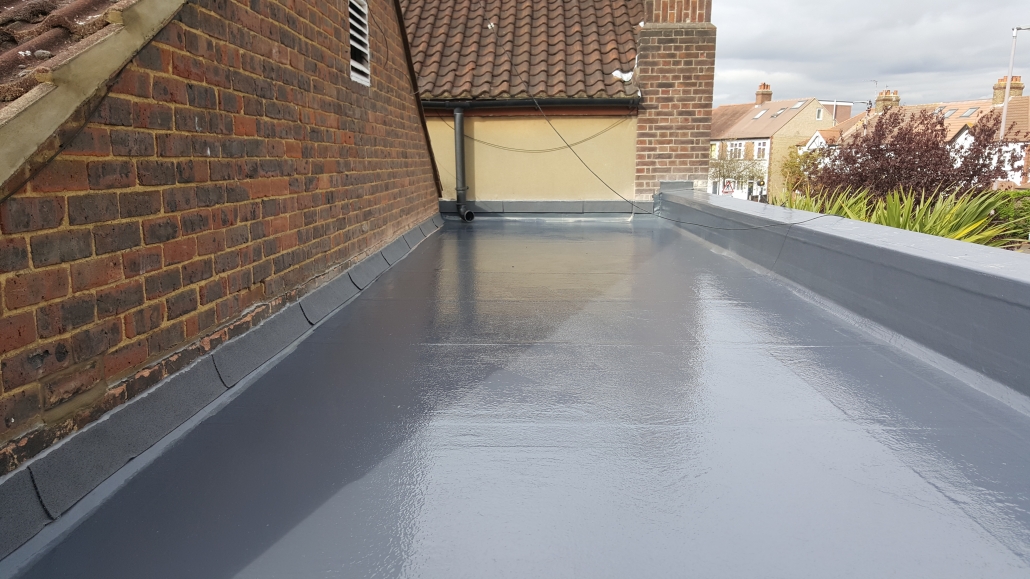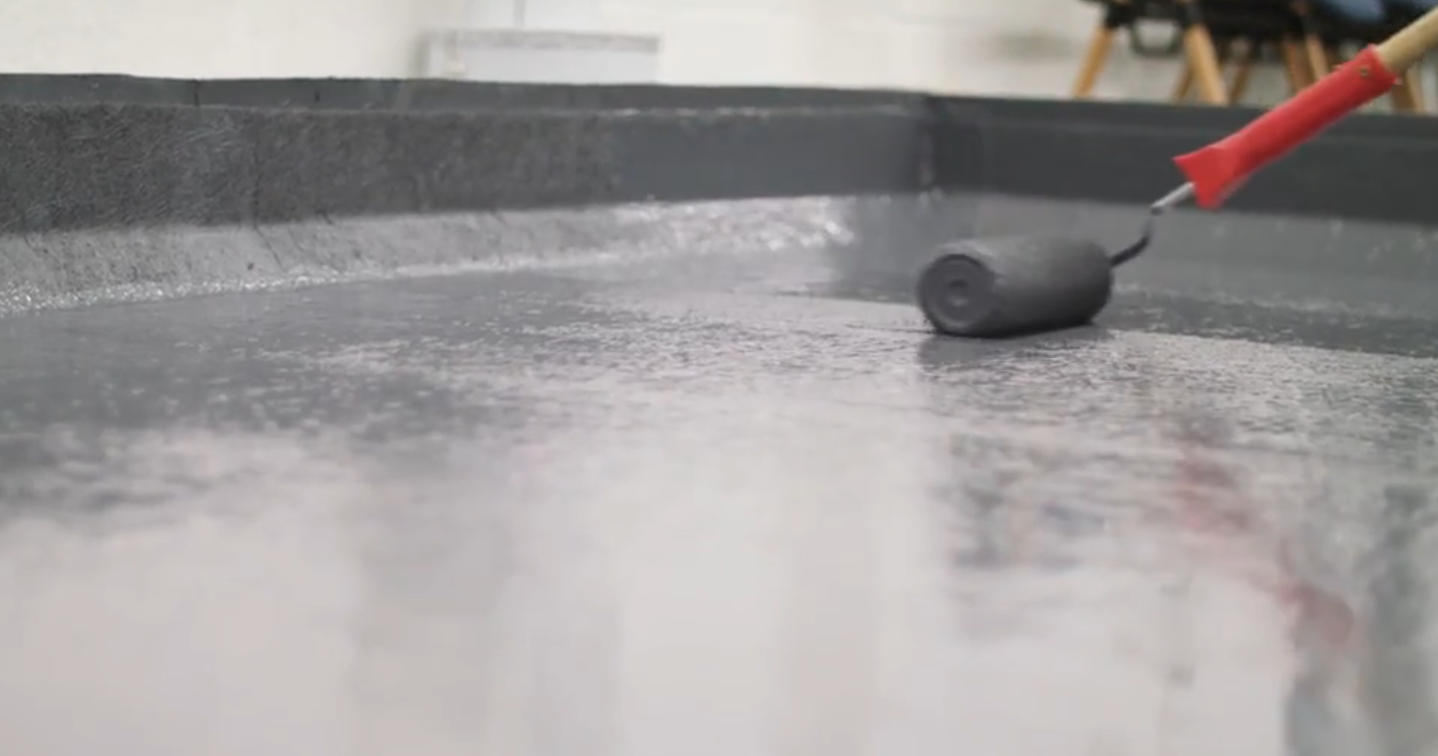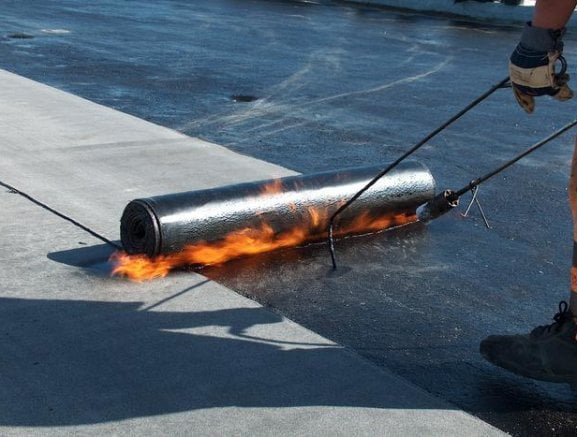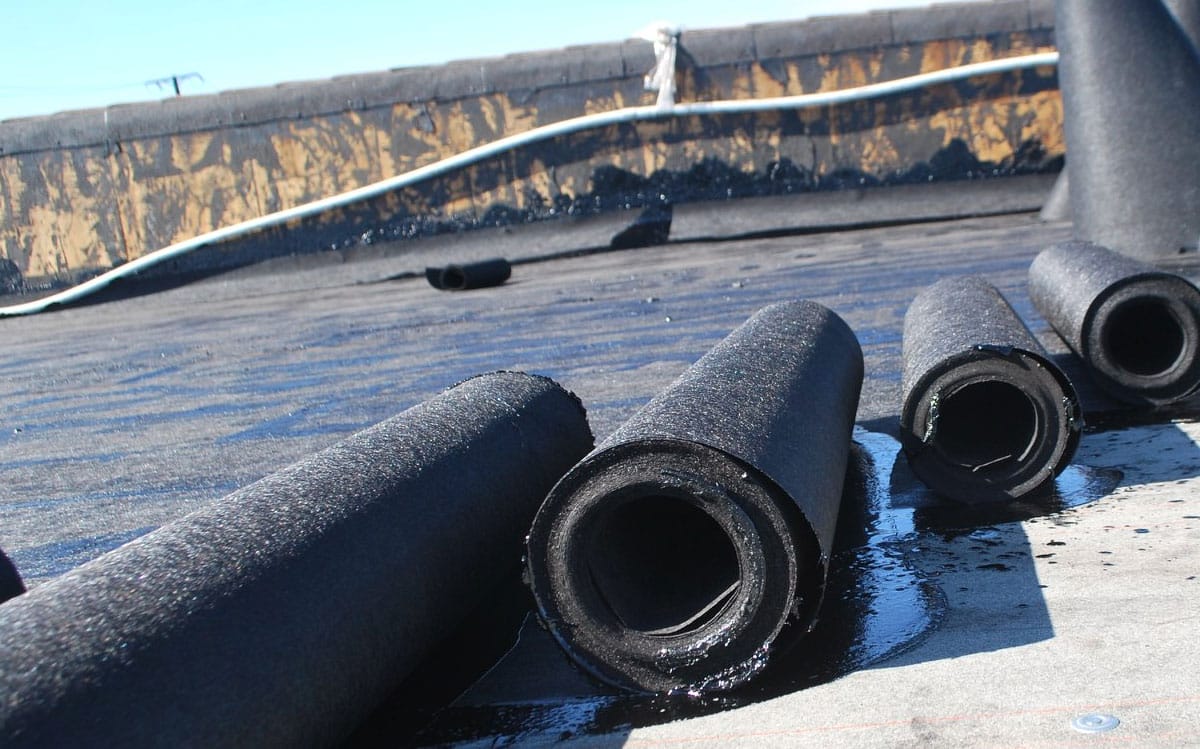Choosing the right roofing material for your flat roof can feel like navigating a maze of technical jargon and countless options. From EPDM to GRP, liquid rubber, and torch-on, each material offers unique benefits and challenges. But how do you determine which is the best fit for your home or commercial property? Let’s demystify these roofing options and help you make an informed decision for a durable, efficient, and aesthetically pleasing flat roof.
EPDM Roofing
Ethylene Propylene Diene Monomer (EPDM) is an exceptionally durable synthetic rubber roofing membrane widely used in low-slope buildings. Known for its exceptional durability and weather resistance, EPDM is available in both black and white and comes in a variety of widths and thicknesses to suit different roofing needs. The material’s flexibility and ability to withstand temperature extremes make it an ideal choice for various climates.
EPDM roofs can last up to 50 years with proper maintenance. Installation involves either fully adhering, mechanically attaching, or ballasting the membrane, providing flexibility in application methods. One of the key advantages of EPDM is its resistance to ultraviolet (UV) radiation and ozone, which helps prevent cracking and degradation over time. Additionally, EPDM is relatively easy to repair, which can significantly extend the roof’s lifespan.
GRP Roofing

Glass Reinforced Plastic (GRP) roofing, also known as fiberglass roofing, is a modern and highly durable flat roofing option. Composed of a polyester resin reinforced with glass fibres, GRP forms a strong, seamless, and watertight membrane once applied. This material is particularly popular for its aesthetic appeal and long-lasting performance.
GRP roofs are known for their durability, often lasting over 25 years with minimal maintenance. The installation process involves applying a base layer of resin, followed by a layer of fiberglass matting, and finishing with another layer of resin and a topcoat. This creates a smooth, attractive finish that can be coloured to suit individual preferences. GRP is highly resistant to UV radiation, chemicals, and fire, making it a robust choice for various environmental conditions.
The seamless nature of GRP roofing eliminates the risk of leaks, a common issue with flat roofs. However, it is crucial to have the installation done by experienced professionals, as improper application can lead to problems down the line. While the initial cost of GRP roofing can be higher than other options, its longevity and minimal maintenance requirements often make it a cost-effective choice in the long run.
Liquid Rubber Roofing

Liquid rubber roofing, also known as liquid-applied roofing, is a versatile and highly effective solution for flat roofs. This method involves applying a liquid rubber membrane directly onto the roof surface, which then cures to form a seamless, waterproof layer. Liquid rubber is particularly valued for its ease of application and its ability to conform to various roof shapes and structures.
One of the primary benefits of liquid rubber roofing is its excellent waterproofing capabilities. The seamless application means there are no joints or seams that could potentially leak, providing a high level of protection against water infiltration. Liquid rubber is also highly flexible, which allows it to expand and contract with temperature changes without cracking or becoming brittle.
This type of roofing is also known for its quick and straightforward installation process. It can be applied using a brush, roller, or spray, making it suitable for both small repairs and large-scale roofing projects. Additionally, liquid rubber is environmentally friendly, as it often contains low levels of volatile organic compounds (VOCs) and is resistant to UV radiation, which helps to extend its lifespan.
Liquid rubber roofs require minimal maintenance, but occasional inspections and cleaning can help prolong their effectiveness. While the initial application may require precise conditions to ensure proper curing, the end result is a durable and long-lasting roof that can provide excellent protection for up to 25 years.
Torch-On Roofing

Torch-on roofing, also known as torch-down roofing, is a popular flat roofing solution that involves applying a bitumen membrane using a propane torch. This method ensures a strong, waterproof seal that is particularly effective in protecting against leaks and harsh weather conditions.
Torch-on roofing membranes typically consist of an asphalt compound reinforced with polyester or fiberglass. During installation, the membrane is heated with the torch, causing it to adhere securely to the roof surface. This creates a durable and seamless layer that is resistant to water infiltration. Torch-on roofing is often applied in multiple layers, with a base layer providing structural support and a cap sheet offering additional protection and UV resistance.
One of the main advantages of torch-on roofing is its exceptional durability. When installed correctly, torch-on roofs can last up to 20 years or more with minimal maintenance. They are also highly resistant to extreme weather conditions, including heavy rain, snow, and high winds. The UV-resistant properties of the top layer help prevent degradation from prolonged sun exposure, ensuring long-term performance.
However, the installation process requires skilled professionals due to the use of an open flame. Safety precautions are essential to prevent accidents, and the roofing contractor must ensure that the underlying structure is suitable for this type of application. Despite the higher installation costs, the longevity and reliability of torch-on roofing often make it a worthwhile investment for flat roofs.
Modified Bitumen Roofing

Modified bitumen roofing is a highly durable and flexible roofing option for flat roofs, combining traditional asphalt with modern polymerised materials. This type of roofing system is designed to withstand extreme weather conditions and provide long-lasting protection for residential and commercial buildings.
Modified bitumen roofing consists of multiple layers, including a base sheet, one or more reinforcing sheets, and a top cap sheet. These layers are bonded together using heat or adhesive, creating a robust and seamless membrane. The polymers added to the asphalt enhance its flexibility and durability, allowing it to expand and contract with temperature changes without cracking.
One of the key benefits of modified bitumen roofing is its resistance to water infiltration. The multi-layered construction and strong seams provide excellent waterproofing capabilities, making it ideal for areas prone to heavy rainfall or snow. Additionally, the surface of modified bitumen can be treated with reflective coatings to improve energy efficiency by reducing heat absorption.
Installation methods for modified bitumen roofing include torch-down, cold-applied, and self-adhesive systems. Each method has its advantages and is chosen based on the specific requirements of the project. For example, torch-down installation provides a strong bond but requires skilled professionals due to the use of an open flame, while self-adhesive systems offer a safer and easier application process.
Modified bitumen roofs typically have a lifespan of 20-30 years with proper maintenance. Regular inspections and prompt repairs of any damage can help extend the roof's longevity. The combination of durability, flexibility, and waterproofing makes modified bitumen a popular choice for flat roofs in both residential and commercial settings.
TPO Roofing

Thermoplastic Olefin (TPO) roofing is a single-ply roofing membrane that has gained popularity for its energy efficiency and cost-effectiveness. TPO roofing systems are made from a blend of polypropylene and ethylene-propylene rubber, providing a durable and flexible membrane suitable for various flat roofing applications.
TPO roofing membranes are known for their excellent reflective properties, which help reduce energy costs by reflecting sunlight and heat away from the building. This makes TPO an environmentally friendly option, as it can significantly improve a building's energy efficiency and reduce cooling costs. The white surface of TPO roofs meets the EPA's ENERGY STAR requirements, making it a preferred choice for green building projects.
The installation process for TPO roofing is relatively straightforward and can be accomplished through various methods, including mechanical attachment, fully adhered systems, and ballasting. The seams of TPO membranes are typically heat-welded, creating a strong and watertight bond that enhances the roof's durability and resistance to leaks.
TPO roofing systems are highly resistant to UV radiation, chemical exposure, and punctures, ensuring long-term performance with minimal maintenance. The flexible nature of TPO allows it to accommodate building movements and temperature fluctuations without compromising its integrity. With a lifespan of 20-30 years, TPO roofs offer a reliable and cost-effective solution for flat roofing needs.
Regular inspections and maintenance are essential to ensure the longevity of TPO roofs. Cleaning the surface to remove debris and checking for any signs of damage can help maintain the roof's performance and appearance. Overall, TPO roofing combines energy efficiency, durability, and ease of installation, making it a versatile and practical choice for flat roofs.
Environmental Impact of Flat Roofing Options

When selecting a flat roofing material, considering the environmental impact is crucial for homeowners and businesses striving to reduce their ecological footprint. Let’s explore the environmental implications of EPDM, GRP, liquid rubber, torch-on, modified bitumen, and TPO roofing.
EPDM Roofing
EPDM (Ethylene Propylene Diene Monomer) is one of the more environmentally friendly roofing options available. It is made from recyclable materials, and its production process generates relatively low levels of pollutants. EPDM's longevity, often exceeding 50 years, reduces the need for frequent replacements, thereby minimising waste. Additionally, EPDM can be recycled at the end of its life, further reducing its environmental impact. Some manufacturers also offer EPDM with enhanced reflective properties, improving energy efficiency by reducing the heat absorbed by the building.
GRP Roofing
Glass Reinforced Plastic (GRP) roofing, while durable and long-lasting, has a higher environmental impact during its production phase compared to some other options. The manufacturing process for GRP involves the use of polyester resins and fiberglass, both of which are energy-intensive to produce. However, GRP roofs' long lifespan (over 25 years) and low maintenance requirements help offset some of the initial environmental costs. At the end of its life, GRP is not as easily recyclable as other materials, which can be a drawback from a sustainability perspective.
Liquid Rubber Roofing
Liquid rubber roofing, or liquid-applied roofing, is typically made from materials with low levels of volatile organic compounds (VOCs), making it a relatively eco-friendly option. The application process creates a seamless and highly durable membrane that can extend the roof's lifespan and reduce the need for frequent repairs and replacements. Liquid rubber can be applied over existing roofing materials, which minimises waste and avoids the environmental impact associated with disposing of old roofing materials. Its flexibility and UV resistance also contribute to energy efficiency by maintaining a stable indoor temperature.
Torch-On Roofing
Torch-on roofing, also known as torch-down roofing, involves the use of bitumen, a petroleum-based product. The production and application of bitumen can have significant environmental impacts, including the release of greenhouse gases and other pollutants. However, torch-on roofs' durability and resistance to extreme weather conditions mean they can last up to 20 years or more, reducing the frequency of replacements. The key to minimising the environmental impact of torch-on roofing is ensuring proper installation and maintenance to maximise its lifespan.
Modified Bitumen Roofing
Modified bitumen roofing shares some similarities with torch-on roofing, particularly in terms of the use of bitumen. The addition of polymers to the asphalt enhances its durability and flexibility, which can extend the roof's lifespan to 20-30 years. Modified bitumen roofs can also be treated with reflective coatings to improve energy efficiency. While the production process is energy-intensive, the long-term benefits of reduced maintenance and energy savings can offset some of the initial environmental costs. Additionally, some modified bitumen membranes are now made with recycled materials, further reducing their ecological footprint.
TPO Roofing
Thermoplastic Olefin (TPO) roofing is celebrated for its environmental benefits. TPO membranes are made from recyclable materials and can be recycled at the end of their life, reducing landfill waste. TPO roofing's highly reflective surface helps lower energy costs by reflecting sunlight and reducing heat absorption, which is particularly beneficial in warm climates. The production process for TPO involves fewer harmful chemicals compared to other roofing materials, making it a more environmentally friendly option. With a lifespan of 20-30 years, TPO roofs provide a sustainable and cost-effective solution for flat roofing needs.
Making the Right Choice for Your Flat Roof
With a variety of flat roofing options available, selecting the right material for your home or commercial property requires careful consideration of your specific needs, budget, and long-term goals. EPDM, GRP, liquid rubber, torch-on, modified bitumen, and TPO each offer unique advantages and challenges, making them suitable for different situations.
Consulting with a professional roofing contractor can help you navigate these options and choose the best solution for your flat roof. Whether you prioritise durability, energy efficiency, ease of installation, or aesthetic appeal, there is a flat roofing material that will meet your requirements. Contact us today to schedule a consultation and take the first step toward a durable, efficient, and visually appealing flat roof that will protect your property for years to come.
Choose your Flat Roof Supplies with Roofing Supplies UK
Ready to upgrade to durable and stylish roofing? Explore our extensive range of Flat Roof Sheets and Materials at Roofing Supplies UK. Contact us today to find the perfect solution for your needs! Email us at sales@roofingsuppliesuk.co.uk, call us at 01752 466151, or order online 24 hours a day, seven days a week. We’ll be able to help you purchase your roofing supplies now.

